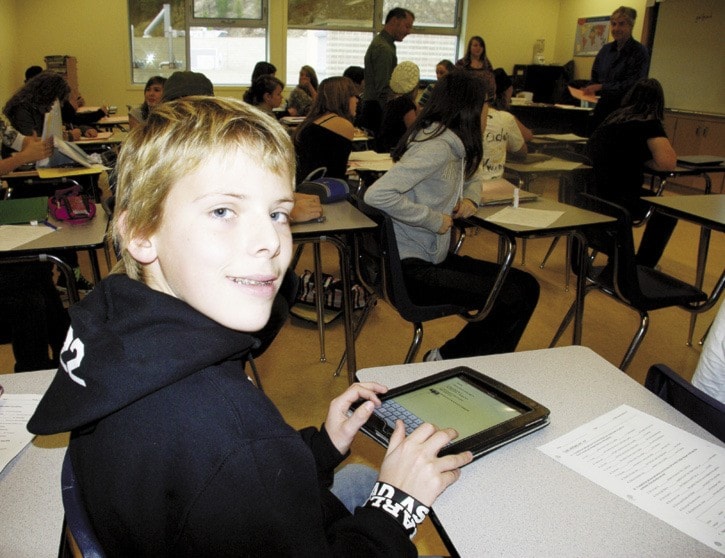Trail’s high school is putting learning literally in the hands of its students with the implementation of iPads in the classroom.
J. L. Crowe’s Parent Advisory Council raised enough funds last year to purchase 10 iPads to use as a pilot program with its Grade 8s. Now with funding from School District 20 to expand its fleet, the school has rolled out an additional 30 learning tools this year.
“The reality is it’s just another enhancement to learning, it’s taking advantage of existing technologies to improve student achievement,” said Crowe principal David DeRosa. “But there is still nothing like sitting down with a good book and flipping through the pages.”
Crowe is not the only local school that has added technology to its way of personalizing learning.
School District 20 spent about $80,000 on the purchase of 160 iPads to use at the Trail high school along with Fruitvale Elementary, Webster Elementary, MacLean Elementary, Kinnaird Elementary, Twin Rivers Elementary and Castlegar Primary. While some schools – Rossland Secondary, Stanley Humphries and Glenmerry Elementary – opted for laptops instead.
“Not many of our students in our school with our age group have portable devices at home,” said Patrick Audet, principal of Glenmerry Elementary.
Crowe on the other hand has found the new tool fits in well with its students.
The iPads can be signed out by teachers who get their students to do research in class, rather than at a computer lab, or use learning applications on the devices that tie in well with textbook curriculum.
But students, who have expressed some challenges in learning, are also using them more frequently.
“It’s always been my genuine belief that along the way where we see the most significant improvement in achievement with technology is in our special education and support areas,” said DeRosa.
“We have kids who have gone on a leaving certificate pathway to a graduation certificate pathway, which means it opens up a whole ton of post secondary learning and career paths.”
Grade 8 student John Ferguson said his grades have improved since he started using an iPad at school this year.
“It’s easier because all of my textbooks are on here so I don’t have to haul them around,” he said. “My writing is really messy and I couldn’t read it before when I was studying for a test, typing works much better now.”
Ferguson not only has his textbooks downloaded to his iPad, but he also uses it as an agenda, note pad, camera and for video for certain class projects.
Crowe is also expanding its digital curriculum through its Curriculum Support Integration (CSI), a classroom that is primarily online but with a teacher present to help students complete their courses.
This is a huge benefit for teens like Joel McNinch, 18, who does home schooling but comes into the high school’s CSI room to work on a Grade 10 planning course, which he needs for graduation.
“We still want to have that sort of face-to-face teacher connection no matter what the class is that they’re taking because we’re human beings and being able to sit down and talk through with another human being is a very important part of our DNA,” said DeRosa.
The high school has also just implemented a secure social learning network for teachers to use.
Edmodo, which can be accessed from any kind of digital device, is an online framework that students can go to find homework assignments and class communication.
